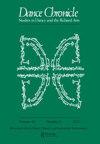Around the Mirror Ball: The Globalization and Glocalization of Disco
IF 0.1
3区 艺术学
0 DANCE
引用次数: 0
Abstract
The anthology Global Dance Cultures in the 1970s and 1980s: Disco Heterotopias, co-edited by Flora Pitrolo and Marko Zubak, offers an interdisciplinary examination of the global spread and local interpretations of disco music and disco culture within a historical period shaped by social change, political conflict, and the globalization of mass media industries. With rigorously researched contributions by scholars, DJs, and musical experts representing different fields, scenes, and national locales, the anthology achieves its stated purpose of examining “how disco acquired different forms, meanings and functions as it was adopted and re-imagined” across distinct social, cultural, political, economic, and industrial contexts (p. 1). Most significantly, the anthology expands scholarship on disco’s routes and cultural meanings beyond extant studies of the rise and fall of disco in the U.S. context. Bringing together ideas from popular music, cultural studies, and media studies, the contributors, many of whom write from non-U.S. or U.K. positions, collectively offer generative theoretical frameworks and methods to envision and comprehend the globalizing and glocalizing of pop culture. While the focus on moving bodies is uneven across chapters, dance and performance scholars invested in embodied flows of popular, mediated culture stand to benefit from the wealth of perspectives and historical information included in the volume’s exploration of global dance music cultures. The introduction, co-written by Pitrolo and Zubak, provides two epistemological frames for considering diverse iterations of disco during the 1970s and ‘80s and configuring new disco historiographies. First is Michel Foucault’s notion of heterotopia, “a term rooted in the spatial and able to account for a simultaneous participation in different geographical and imaginary regimes” which is invoked via disco’s most iconic symbol, the mirror ball (p. 5). The glittering mirror ball, with its ability to refract, scatter, and multiply a single light and transform an environment into a real yet unreal space, points to how each disco culture “draws into itself the disco paradigm as imaginary cipher围绕着镜子球:迪斯科的全球化和全球本土化
由Flora Pitrolo和Marko Zubak共同编辑的选集《20世纪70年代和80年代的全球舞蹈文化:迪斯科异托皮亚》,对社会变革、政治冲突和大众媒体行业全球化所塑造的历史时期内迪斯科音乐和迪斯科文化的全球传播和地方诠释进行了跨学科的研究。凭借代表不同领域、场景和国家地区的学者、DJ和音乐专家的严谨研究,该选集实现了其既定目的,即在不同的社会、文化、政治、经济和工业背景下研究“迪斯科是如何在被采用和重新想象时获得不同的形式、意义和功能的”(第1页)。最重要的是,这本选集扩展了对迪斯科路线和文化意义的研究,超越了对迪斯科在美国兴起和衰落的现有研究。撰稿人汇集了流行音乐、文化研究和媒体研究的观点,其中许多人来自非美国。美国或英国的立场共同提供了设想和理解流行文化全球化和全球化的生成性理论框架和方法。虽然各章节对移动身体的关注不均衡,但舞蹈和表演学者对流行、中介文化的具体流动进行了投资,他们将受益于该卷对全球舞曲文化的探索中所包含的丰富视角和历史信息。该引言由Pitrolo和Zubak合著,提供了两个认识论框架,用于考虑20世纪70年代和80年代迪斯科的不同迭代,并配置新的迪斯科历史。首先是米歇尔·福柯的异托邦概念,“一个植根于空间的术语,能够解释同时参与不同的地理和想象制度”,这是通过迪斯科最具标志性的符号——镜像球来引用的(第5页)。闪闪发光的镜面球能够折射、散射和倍增单个光线,并将环境转化为真实而不真实的空间,它指出了每一种迪斯科文化是如何“将迪斯科范式作为想象中的密码”引入自身的
本文章由计算机程序翻译,如有差异,请以英文原文为准。
求助全文
约1分钟内获得全文
求助全文
来源期刊

DANCE CHRONICLE
DANCE-
CiteScore
0.40
自引率
0.00%
发文量
22
期刊介绍:
For dance scholars, professors, practitioners, and aficionados, Dance Chronicle is indispensable for keeping up with the rapidly changing field of dance studies. Dance Chronicle publishes research on a wide variety of Western and non-Western forms, including classical, avant-garde, and popular genres, often in connection with the related arts: music, literature, visual arts, theatre, and film. Our purview encompasses research rooted in humanities-based paradigms: historical, theoretical, aesthetic, ethnographic, and multi-modal inquiries into dance as art and/or cultural practice. Offering the best from both established and emerging dance scholars, Dance Chronicle is an ideal resource for those who love dance, past and present. Recently, Dance Chronicle has featured special issues on visual arts and dance, literature and dance, music and dance, dance criticism, preserving dance as a living legacy, dancing identity in diaspora, choreographers at the cutting edge, Martha Graham, women choreographers in ballet, and ballet in a global world.
 求助内容:
求助内容: 应助结果提醒方式:
应助结果提醒方式:


